The GAA must be pleased at how the Fifa World Cup is progressing. For one thing, there’s the decision to follow the association’s example from 2020 and have a winter championship. This has conveniently taken the biggest sports event on Earth out of the orbit of Gaelic games’ busiest period during the summer.
Then there has been world soccer’s blundering from one PR catastrophe to the next in Qatar, which has been a fair old distraction from the brutalising of referees at club matches.
The interaction of global soccer’s showpiece and the GAA has been a matter of interest to the association and its own events for over 50 years.
In the Report of the Commission on the GAA in 1971, there is specific reference in the section on broadcasting.
READ MORE
“With the relatively high percentage of programmes being devoted to sport (about nine per cent in 1970), it was inevitable also that the medium would affect sports organisations.
“It is said that TV has been largely responsible for the upsurge of the interest in golf while interest generated by the World Cup soccer competitions in 1966 and 1970 undoubtedly strengthened the development of that game in Ireland.”
The memory of the 1970 final would have been fresh in the minds of the authors, as it was the first tournament broadcast in colour, although most of the population would have had to take that on trust. It was also the first to harness fully satellite technology, launched in 1962.
That was the same summer as the World Cup in Chile, which became the last to rely on filmed footage as the primary access point for followers around the world.
That commission line about the influence of the 1966 World Cup on GAA members is well practised at this stage. It is generally accepted that it contributed to the shift in opinion on the issue of the ban on foreign sports.
Of course, it wasn’t that there was no soccer in Ireland until 1966, but that year’s World Cup was the point at which people within the GAA developed an interest in the sport.
That year saw for the first time broadcast coverage of the tournament on RTÉ but it’s interesting to note that this was not by any means comprehensive. Live coverage was restricted to England’s matches and the knockout stages and there was a highlights programme at night.
Almost as a reaction, the GAA dipped its toe into live coverage with that year’s Down-Donegal Ulster final screened live the day after the England-West Germany World Cup final went out live on both RTÉ and BBC.
Maybe the fact that the tournament was being played nearby in England also had an effect but the key influence appears to have been the growing stature of the tournament and the nightly live matches available on BBC.
If all of this appears a bit tame for the seismic effect attributed to it, remember that there had been nothing up to that point.

The previous tournament was all but anonymous. Played in Chile, the final was staged on June 17th. In this ‘paper there was a modest preview on page three, chiefly concerned with Pele being ruled out of the final by Brazil’s team doctor Hilton Gosling.
Czechoslovakia were dutifully contrasted with the flamboyant champions in a reference to “the dour defensive tactics of the East Europeans”.
The preview was considerably shorter, though, than the piece beside it looking forward to the Dublin-Laois Leinster football semi-final in Carlow.
On the television page the weekend schedules are free from any programming to do with the World Cup. There is a 20-minute sports round-up on Teilifís Éireann at 9.15 in the evening – during whose running time the final would have ended and the result may have been broadcast – and boxing on UTV.
The next day’s Irish Times contained a full report on Dublin’s narrow victory and, down the side of the same page, seven paragraphs on Brazil retaining their title (neither event as important as Surrey losing but maintaining their lead in English cricket’s county championship).
The challenge for the GAA in more recent times was rendered more acute by the eventual arrival of the Republic of Ireland at a tournament in 1990 – Northern Ireland had already qualified three times by then, although posing less of threat to championship schedules.
Experience indicates that if Ireland are at a World Cup, there is an impact on GAA attendances. As this hasn’t happened for 20 years, it didn’t become a problem. The association did, however, prove slow learners.
That summer of 1990 saw some ill-advised scheduling clashes. On the Sunday of the Ireland-Egypt match, Leinster hurling semi-finals took place in Croke Park and a Donegal-Derry Ulster football semi-final in Clones. Crowds of 17,436 and 5,000 were in attendance.
The Offaly-Kilkenny match was notable for the senior debuts of two illustrious hurlers, Brian Whelahan and DJ Carey. History was also made when the Croke Park scoreboard showed updates from Palermo – the first time soccer scores had been announced at the stadium.
The only other direct clash came in 2002 when Ireland played Spain in a second-round match. Once again, Donegal and Derry rolled up to Clones to provide a counter-attraction but drew an even smaller crowd than in 1990.
The GAA couldn’t bring itself to publish the attendance in the annual report – the only championship match to go unrecorded that year – but estimates were between 2,000 at throw-in and 4,000 once the soccer was over.
One journalist keeping track of events in Korea on a potable television was upbraided for his cultural promiscuity by an Ulster Council official.
This time around, the more intimate attractions of club matches will have to do battle with Japan-Costa Rica, Belgium-Morocco, Croatia-Canada and a second-round match.
Evidence suggests that the GAA will survive.
















